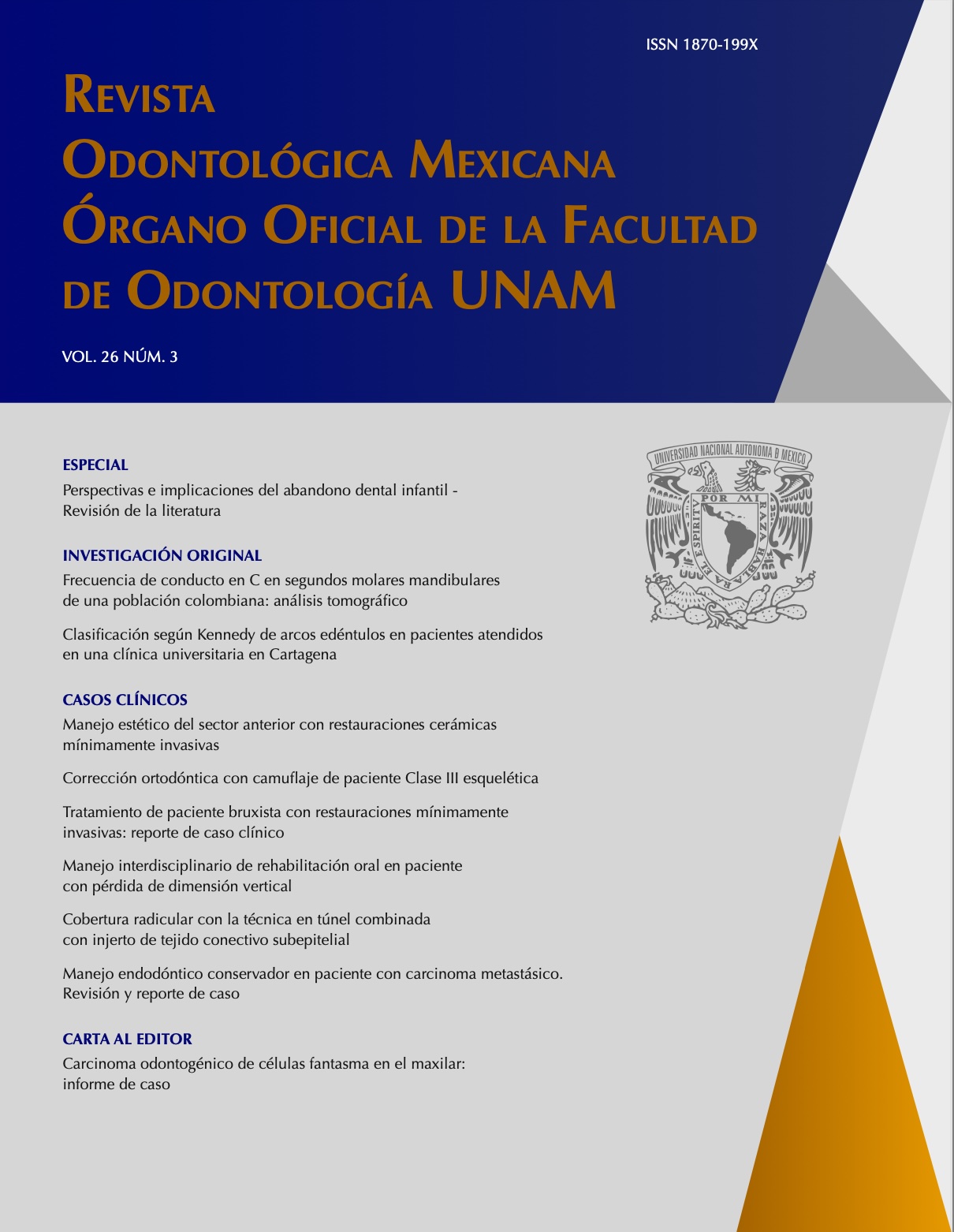Orthodontic Correction with Camouflage of Skeletal Class III Patient
Main Article Content
Abstract
Introduction: One of the main problems in orthodontics treatment with skeletal Class III patients is making the decision on how to carry out the treatment, deciding whether to perform surgery, or orthodontic camouflage with or without extractions. A 13-year-old female patient presents with Class III skeletal, anterior crossbite, straight profile, Class I molar, Class III canine left subdivision. Objectives: To present the orthodontic follow-up of a Class III patient who underwent orthodontic camouflage without extractions. Case presentation: Prescription MBTTM 0.022” appliances and Essix retainer with acrylic planas direct track were used in the mandibular dental arch, to lift the bite and give the opportunity to vestibularise the antero-maxillary sector and correct the crossbite. Starting with the alignment and levelling phase, using archwires. An orthopantomography was requested to verticalise roots and was completed with braided archwires and intermaxillary elastics for detailing. As a result, the anterior crossbite was corrected, the straight profile was maintained, we achieved Class I molar and canine, and the smile was improved. Conclusions: It is possible to successfully camouflage a Class III patient as long as we know the skeletal, facial, dental and functional limits of each patient.
Article Details
Citas en Dimensions Service
References
Johnston C, Burden D, Kennedy D, Harradine N, Stevenson M. Class III surgical-orthodontic treatment: A cephalometric study. Am J Orthod Dentofacial Orthop. 2006; 130(3):300-309. DOI: 10.1016/j.ajodo.2005.01.023
Eslami S, Faber J, Fateh A, Sheikholaemmeh F, Grassia V, Jamilian A. Treatment decision in adult patients with class III malocclusion: Surgery versus orthodontics. Prog Orthod. 2018; 19(1):28. DOI: 10.1186/s40510-018-0218-0
Stellzig-Eisenhauer A, Lux CJ, Schuster G. Treatment decision in adult patients with Class III malocclusion: Orthodontic therapy or orthognathic surgery? Am J Orthod Dentofacial Orthop. 2002; 122(1):27-37. DOI: 10.1067/mod.2002.123632
Lee GC, Yoo JK, Kim SH, Moon CH. Lip line changes in Class III facial asymmetry patients after orthodontic camouflage treatment, one-jaw surgery, and two-jaw surgery: A preliminary study. Angle Orthod. 2017; 87(2):239-245. DOI: 10.2319/033016-254.1
Kim SJ, Kim KH, Yu HS, Baik HS. Dentoalveolar compensation according to skeletal discrepancy and overjet in skeletal Class III patients. Am J Orthod Dentofacial Orthop. 2014; 145(3):317-324. DOI: 10.1016/j.ajodo.2013.11.014
Burns NR, Musich DR, Martin C, Razmus T, Gunel E, Ngan P. Class III camouflage treatment: What are the limits? Am J Orthod Dentofacial Orthop. 2010; 137(1):9.e1-9.e13. DOI: 10.1016/j.ajodo.2009.05.017
Troy BA, Shanker S, Fields HW, Vig K, Johnston W. Comparison of incisor inclination in patients with Class III malocclusion treated with orthognathic surgery or orthodontic camouflage. Am J Orthod Dentofacial Orthop. 2009; 135(2):146.e1-146.e9. DOI: 10.1016/j.ajodo.2008.07.012
Kerr WJS, Miller S, Dawber JE. Class III malocclusion: Surgery or orthodontics? Br J Orthod. 1992; 19(1):21-24. DOI: 10.1179/bjo.19.1.21
Baik HS. Limitations in orthopedic and camouflage treatment for Class III malocclusion. Semin Orthod. 2007; 13(3):158-174. DOI: 10.1053/j.sodo.2007.05.004
Asensi JC. Proposition d’un protocole définissant les facteurs limites des traitements de compensation de la classe III. [Limiting factors in the class III camouflage treatment: a potential protocol]. Orthod Fr. 2016; 87(2):205-228. DOI: 10.1051/orthodfr/2016023
Kang TJ, Eo SH, Cho HJ, Donatelli RE, Lee SJ. A sparse principal component analysis of Class III malocclusions. Angle Orthod. 2019; 89(5):768-774. DOI: 10.2319/100518-717.1
Jang SJ, Choi DS, Jang I, Jost-Brinkmann PG, Cha BK. Quantitative comparison of incisal tooth wear in patients receiving one-phase or two-phase treatment for skeletal Class III malocclusion with anterior crossbite. Angle Orthod. 2018; 88(2):151-156. DOI: 10.2319/080817-532.1
Koo YJ, Choi SH, Keum BT, Yu HS, Hwang CJ, Melsen B, et al. Maxillomandibular arch width differences at estimated centers of resistance: Comparison between normal occlusion and skeletal Class III malocclusion. Korean J Orthod. 2017; 47(3):167-175. DOI: 10.4041/kjod.2017.47.3.167
Palczikowski LY, Collante CI. Diagnóstico de Clase III: identificación del patrón esqueletal. Rev Fac Odont. 2016; 9(1):50-54. DOI: 10.30972/rfo.911599
Ngan P, Moon W. Evolution of Class III treatment in orthodontics. Am J Orthod Dentofacial Orthop. 2015; 148(1):22-36. DOI: 10.1016/j.ajodo.2015.04.012
Bou Wadi MN, Freitas KMS, Freitas DS, Cançado RH, de Oliveira RCG, de Oliveira RG, et. al. Comparison of profile attractiveness between Class III orthodontic camouflage and predictive tracing of orthognathic surgery. Int J Dent. 2020:7083940. DOI: 10.1155/2020/7083940
De Oliveira RCG, de Oliveira RG, Da Costa JV, Voss MA. Compensatory treatment of skeletal Class III malocclusion with self-ligation appliance. J Surg Clin Dent. 2015; 6(1):25-28.
Farret MM, Farret MMB, Farret AM. Orthodontic camouflage of skeletal Class III malocclusion with miniplate: A case report. Dental Press J Orthod. 2016; 21(4):89-98. DOI: 10.1590/2177-6709.21.4.089-098.oar
Park JH, Emamy M, Lee SH. Adult skeletal Class III correction with camouflage orthodontic treatment. Am J Orthod Dentofacial Orthop. 2019; 156(6):858-869. DOI: 10.1016/j.ajodo.2018.07.029

Revista Odontológica Mexicana por Universidad Nacional Autónoma de México se distribuye bajo una Licencia Creative Commons Atribución-NoComercial-SinDerivar 4.0 Internacional.
Basada en una obra en http://revistas.unam.mx/index.php/rom.
